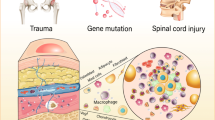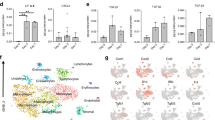Abstract
Heterotopic ossification (HO) is a pathological condition that occurs in soft tissues following severe trauma. The exact pathogenesis of HO remains unclear. Studies have shown that inflammation predisposes patients to the development of HO and triggers ectopic bone formation. Macrophages are crucial mediators of inflammation and are involved in HO development. The present study investigated the inhibitory effect and underlying mechanism of metformin on macrophage infiltration and traumatic HO in mice. Our results found that abundant levels of macrophages were recruited to the injury site during early HO progression and that early administration of metformin prevented traumatic HO in mice. Furthermore, we found that metformin attenuated macrophage infiltration and the NF-κB signaling pathway in injured tissue. The monocyte-to-macrophage transition in vitro was suppressed by metformin and this event was mediated by AMPK. Finally, we showed that inflammatory mediator’s regulation by macrophages targeted preosteoblasts, leading to elevated BMP signaling, and osteogenic differentiation and driving HO formation, and this effect was blocked after the activation of AMPK in macrophages. Collectively, our study suggests that metformin prevents traumatic HO by inhibiting of NF-κB signaling in macrophages and subsequently attenuating BMP signaling and osteogenic differentiation in preosteoblasts. Therefore, metformin may serve as a therapeutic drug for traumatic HO by targeting NF-κB signaling in macrophages.








Similar content being viewed by others
DATA AVAILABILITY
The data that support the findings of this study are available from the corresponding author upon reasonable request.
Abbreviations
- HO:
-
Heterotopic ossification
- NSAID:
-
Non-steroidal anti-inflammatory drugs
- MCP1:
-
Monocyte chemokine
- MIP1-α:
-
Macrophage inflammatory protein 1α
- AMPK:
-
AMP-activated protein kinase
- MAPK:
-
Mitogen-activated protein kinase
- JAK/STAT:
-
JAKs signaling and activator of transcription
- BMP:
-
Bone morphogenetic protein
- LPS:
-
Lipopolysaccharides
- ALP:
-
Alkaline phosphatase
References
Wang, X., F. Li, L. Xie, J. Crane, G. Zhen, Y. Mishina, et al. 2018. Inhibition of overactive TGF-beta attenuates progression of heterotopic ossification in mice. Nature Communications 9: 551.
Martin, E.C., Qureshi, A.T., Llamas, C.B., Boos, E.C., King, A.G., Krause, P.C., et al. 2018. Trauma induced heterotopic ossification patient serum alters mitogen activated protein kinase signaling in adipose stem cells. Journal of Cellular Physiology.
Dey, D., B.M. Wheatley, D. Cholok, S. Agarwal, P.B. Yu, B. Levi, et al. 2017. The traumatic bone: Trauma-induced heterotopic ossification. Translational Research 186: 95–111.
Sorkin, M., Huber, A.K., Hwang, C., Carson, W.F., Menon, R., Li, J., et al. 2020. Regulation of heterotopic ossification by monocytes in a mouse model of aberrant wound healing. Nature Communications 11: 722.
Kraft, C.T., S. Agarwal, K. Ranganathan, V.W. Wong, S. Loder, J. Li, et al. 2016. Trauma-induced heterotopic bone formation and the role of the immune system: A review. The Journal of Trauma and Acute Care Surgery 80: 156–165.
Barfield, W.R., R.E. Holmes, and L.A. Hartsock. 2017. Heterotopic ossification in trauma. The Orthopedic Clinics of North America. 48: 35–46.
Yamaguchi, T. 2012. Diabetes mellitus and osteoporosis. How to start drug therapy for osteoporosis in patients with diabetes mellitus. Clinical Calcium 22: 1403–9.
Askenase, M.H., and L.H. Sansing. 2016. Stages of the inflammatory response in pathology and tissue repair after intracerebral hemorrhage. Seminars in Neurology 36: 288–297.
Eming, S.A., T.A. Wynn, and P. Martin. 2017. Inflammation and metabolism in tissue repair and regeneration. Science 356: 1026–1030.
Charles, J.F., and M.C. Nakamura. 2014. Bone and the innate immune system. Current Osteoporosis Reports 12: 1–8.
Li, J., Z. Sun, G. Luo, S. Wang, H. Cui, Z. Yao, et al. 2021. Quercetin attenuates trauma-induced heterotopic ossification by tuning immune cell infiltration and related inflammatory insult. Frontiers in Immunology 12: 649285.
Matsuo, K., R.D. Chavez, E. Barruet, and E.C. Hsiao. 2019. Inflammation in fibrodysplasia ossificans progressiva and other forms of heterotopic ossification. Current Osteoporosis Reports 17: 387–394.
Forsberg, J.A., B.K. Potter, E.M. Polfer, S.D. Safford, and E.A. Elster. 2014. Do inflammatory markers portend heterotopic ossification and wound failure in combat wounds? Clinical Orthopaedics and Related Research 472: 2845–2854.
Evans, K.N., J.A. Forsberg, B.K. Potter, J.S. Hawksworth, T.S. Brown, R. Andersen, et al. 2012. Inflammatory cytokine and chemokine expression is associated with heterotopic ossification in high-energy penetrating war injuries. Journal of Orthopaedic Trauma 26: e204–e213.
Sung Hsieh, H.H., M.T. Chung, R.M. Allen, K. Ranganathan, J. Habbouche, D. Cholok, et al. 2017. Evaluation of salivary cytokines for diagnosis of both trauma-induced and genetic heterotopic ossification. Frontiers in Endocrinology 8: 74.
Huang, Y., X. Wang, D. Zhou, W. Zhou, F. Dai, and H. Lin. 2021. Macrophages in heterotopic ossification: From mechanisms to therapy. NPJ Regenerative Medicine 6: 70.
Champagne, C.M., J. Takebe, S. Offenbacher, and L.F. Cooper. 2002. Macrophage cell lines produce osteoinductive signals that include bone morphogenetic protein-2. Bone 30: 26–31.
Convente, M.R., H. Wang, R.J. Pignolo, F.S. Kaplan, and E.M. Shore. 2015. The immunological contribution to heterotopic ossification disorders. Current Osteoporosis Reports 13: 116–124.
McCarthy, E.F., and M. Sundaram. 2005. Heterotopic ossification: A review. Skeletal Radiology 34: 609–619.
Convente, M.R., S.A. Chakkalakal, E. Yang, R.J. Caron, D. Zhang, T. Kambayashi, et al. 2018. Depletion of mast cells and macrophages impairs heterotopic ossification in an Acvr 1(R206H) mouse model of fibrodysplasia ossificans progressiva. Journal of Bone and Mineral Research: The Official Journal of the American Society for Bone and Mineral Research 33: 269–282.
Kaplan, F.S., R.J. Pignolo, and E.M. Shore. 2016. Granting immunity to FOP and catching heterotopic ossification in the Act. Seminars in Cell & Developmental Biology 49: 30–36.
Wang, H., Q. Zhang, F.S. Kaplan, and R.J. Pignolo. 2022. Clearance of senescent cells from injured muscle abrogates heterotopic ossification in mouse models of fibrodysplasia ossificans progressiva. Journal of Bone and Mineral Research: The Official Journal of the American Society for Bone and Mineral Research 37: 95–107.
Luo, Z., M. Zang, and W. Guo. 2010. AMPK as a metabolic tumor suppressor: Control of metabolism and cell growth. Future Oncology 6: 457–470.
Wang, L., Luo, Y., Luo, L., Wu, D., Ding, X., Zheng, H., et al. 2021. Adiponectin restrains ILC2 activation by AMPK-mediated feedback inhibition of IL-33 signaling. The Journal of Experimental Medicine 218.
Rena, G., Hardie, D.G., and Pearson, E.R. 2017. The mechanisms of action of metformin. Diabetologia.
Hardie, D.G., Schaffer, B.E. and Brunet, A. 2016. AMPK: An Energy-sensing pathway with multiple inputs and outputs. Trends in Cell Biology 26: 190–201.
Chen, M., J. Zhang, F. Hu, S. Liu, and Z. Zhou. 2015. Metformin affects the features of a human hepatocellular cell line (HepG2) by regulating macrophage polarization in a co-culture microenviroment. Diabetes/Metabolism Research and Reviews 31: 781–789.
Mancini, S.J., and I.P. Salt. 2018. Investigating the role of AMPK in inflammation. Methods in Molecular Biology 1732: 307–319.
Jing, Y., F. Wu, D. Li, L. Yang, Q. Li, and R. Li. 2018. Metformin improves obesity-associated inflammation by altering macrophages polarization. Molecular and Cellular Endocrinology 461: 256–264.
Xiong, W., K.Y. Sun, Y. Zhu, X. Zhang, Y.H. Zhou, and X. Zou. 2021. Metformin alleviates inflammation through suppressing FASN-dependent palmitoylation of Akt. Cell Death & Disease 12: 934.
Winkler, G. 2016. Metformin - new data for an “old”, but efficient, safe and reliable antidiabetic drug. Orvosi Hetilap 157: 882–891.
Koh, S.J., J.M. Kim, I.K. Kim, S.H. Ko, and J.S. Kim. 2014. Anti-inflammatory mechanism of metformin and its effects in intestinal inflammation and colitis-associated colon cancer. Journal of Gastroenterology and Hepatology 29: 502–510.
Lin, H., F. Shi, S. Jiang, Y. Wang, J. Zou, Y. Ying, et al. 2020. Metformin attenuates trauma-induced heterotopic ossification via inhibition of bone morphogenetic protein signalling. Journal of Cellular and Molecular Medicine 24: 14491–14501.
Barruet, E., Morales, B.M., Cain, C.J., Ton, A.N., Wentworth, K.L., Chan, T.V., et al. 2018. NF-kappaB/MAPK activation underlies ACVR1-mediated inflammation in human heterotopic ossification. JCI Insight 3.
Arnold, L., A. Henry, F. Poron, Y. Baba-Amer, N. van Rooijen, A. Plonquet, et al. 2007. Inflammatory monocytes recruited after skeletal muscle injury switch into antiinflammatory macrophages to support myogenesis. The Journal of Experimental Medicine 204: 1057–1069.
Dakin, S.G., Martinez, F.O., Yapp, C., Wells. G., Oppermann, U., Dean, B.J., et al. 2015. Inflammation activation and resolution in human tendon disease. Science Translational Medicine 7: 311ra173.
Li, L., Jiang, Y., Lin, H., Shen, H., Sohn, J., Alexander, P.G., et al. 2019. Muscle injury promotes heterotopic ossification by stimulating local bone morphogenetic protein-7 production. Journal of Orthopaedic Translation 18: 142–53.
Zhang, J., L. Wang, J. Chu, X. Ao, T. Jiang, Y. Bin, et al. 2020. Macrophage-derived neurotrophin-3 promotes heterotopic ossification in rats. Laboratory Investigation 100: 762–776.
Kan, C., J. Yang, D. Na, Y. Xu, B. Yang, H. Zhao, et al. 2019. Inhibition of immune checkpoints prevents injury-induced heterotopic ossification. Bone Research 7: 33.
Rodriguez, C., M. Munoz, C. Contreras, and D. Prieto. 2021. AMPK, metabolism, and vascular function. The FEBS Journal 288: 3746–3771.
Hou, L., F. Jiang, B. Huang, W. Zheng, Y. Jiang, G. Cai, et al. 2021. Dihydromyricetin resists inflammation-induced muscle atrophy via ryanodine receptor-CaMKK-AMPK signal pathway. Journal of Cellular and Molecular Medicine 25: 9953–9971.
Trefts, E., and R.J. Shaw. 2021. AMPK: Restoring metabolic homeostasis over space and time. Molecular Cell 81: 3677–3690.
McCauley, J., C. Bitsaktsis, and J. Cottrell. 2020. Macrophage subtype and cytokine expression characterization during the acute inflammatory phase of mouse bone fracture repair. Journal of orthopaedic research: Official publication of the Orthopaedic Research Society 38: 1693–1702.
Funding
This work was supported by National Nature Science Foundation of China (31900852 to HL), Nature Science Foundation of Jiangxi Province of China (20192ACB21026 and 20224ACB206024 to HL).
Author information
Authors and Affiliations
Contributions
Study conception and design: HL, JH, JC, ZM T, WW Z, and JJ F. JH and JC performed experiments, provided data analysis, and interpretation. ZM T, WW Z, and JJ F performed experiments on animal study and co-culture study. Drafting of the article: JH, JC, and HL. All authors read and approved the final manuscript.
Corresponding author
Ethics declarations
Ethics Approval
All the animal protocol was reviewed and approved by the Animal Care Committee of Nanchang University (NCDXSYDWFL-2015097). The animal procedures were performed strictly in accordance with National Institutes of Health Guide for Animal Care.
Consent to Participate
Not applicable.
Consent for Publication
Not applicable.
Competing Interests
The authors declare no competing interests.
Additional information
Publisher's Note
Springer Nature remains neutral with regard to jurisdictional claims in published maps and institutional affiliations.
Supplementary Information
Below is the link to the electronic supplementary material.
Rights and permissions
Springer Nature or its licensor (e.g. a society or other partner) holds exclusive rights to this article under a publishing agreement with the author(s) or other rightsholder(s); author self-archiving of the accepted manuscript version of this article is solely governed by the terms of such publishing agreement and applicable law.
About this article
Cite this article
Hou, J., Chen, J., Fan, J. et al. Inhibition of NF-κB Signaling-Mediated Crosstalk Between Macrophages and Preosteoblasts by Metformin Alleviates Trauma-Induced Heterotopic Ossification. Inflammation 46, 1414–1429 (2023). https://doi.org/10.1007/s10753-023-01817-2
Received:
Revised:
Accepted:
Published:
Issue Date:
DOI: https://doi.org/10.1007/s10753-023-01817-2




